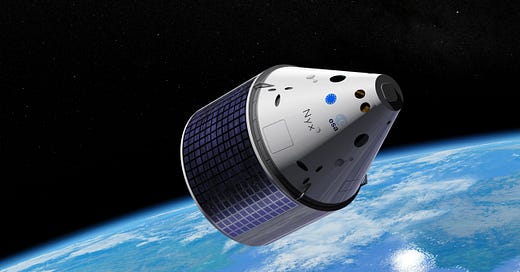The Exploration Company Presents Strategic Plans for Human Spaceflight
European space startup, The Exploration Company, is developing a cargo vehicle with a key test flight launching within days and has long-term plans to fly people as well. The company presented an updated model of its Nyx spacecraft at the Paris Air Show on June 16. It is working on Nyx with plans for a test flight to the International Space Station in 2028 through a European Space Agency program intended to develop cargo spacecraft.
The Exploration Company indicates that Nyx will initially be used for cargo missions but has plans to create a version for crewed flights. The displayed model showed two astronauts on board along with cargo. “We have already completed the initial studies,” said Victor Maier, lead for Germany and central Europe business at the company, during the unveiling event. A fully crewed version of Nyx could accommodate four or five astronauts, with an interior design featuring windows and touchscreen displays similar to SpaceX’s Crew Dragon.
Maier explained that the company is exploring a crewed version now since it needs to support flights to the ISS and future commercial stations where astronauts will enter and work in the vehicle while docked. “So, we’re already meeting some requirements for certifying for human spaceflight once docked to the station.”
A crewed version of Nyx would take about ten years to develop and cost approximately one billion euros ($1.15 billion), according to Maier. He mentioned that this is the time to discuss this work as ESA prepares for its ministerial conference in November in Germany. “We need Europe to decide if we want to have this in Europe,” he said regarding a crewed spacecraft. “This year, at the ministerial conference in Bremen, member states can make this decision.”
He noted that a crewed version would require European government support, likely from ESA, due to the high costs being beyond the scope of private financing or national-level support. “We need Europe because no country alone could undertake this.”
In the meantime, The Exploration Company is focused on the cargo version of Nyx. Maier stated the company has six missions on its manifest, including the demonstration mission for ESA, three missions for Starlab Space, and individual missions for Axiom Space and Vast.
The company launched its first test spacecraft, Mission Bikini, last July on the inaugural Ariane 6 launch. However, the failure of the rocket's upper stage to perform a final deorbit burn prevented the spacecraft from separating and conducting its planned reentry test.
The next test flight, called Mission Possible, involves a larger spacecraft weighing 1.6 tons with a diameter of 2.5 meters. This flight will fully test all technologies needed for Nyx, from reentry through splashdown, rather than just testing reentry systems as in the smaller Mission Bikini. Mission Possible will also carry cargo for customers. Maier indicated it has about 300 kilograms of cargo onboard, including cosmetic and pharmaceutical experiments and alcohol.
Mission Possible will launch on SpaceX’s Transporter-14 mission. Unofficial manifests suggest the Falcon 9 launch from Vandenberg Space Force Base in California is scheduled for as early as June 21 2025. The spacecraft will spend approximately three hours in orbit before deorbiting and splashing down in the Pacific Ocean. Maier mentioned that a recovery ship for the spacecraft had already departed an Alaska port heading to the splashdown location.
There are no current plans by The Exploration Company to fly another test mission after Mission Possible before the ISS demonstration mission, though additional ground tests of some systems may be conducted if required.




